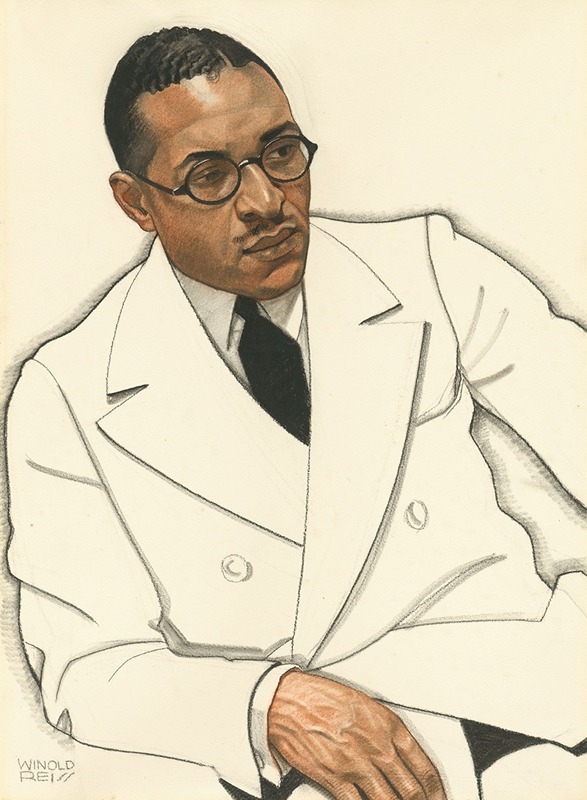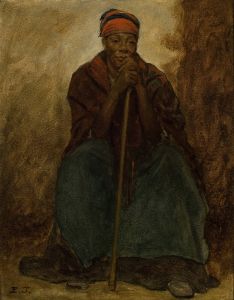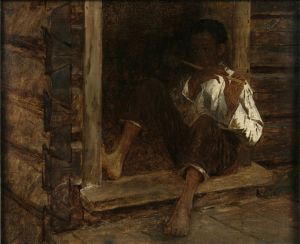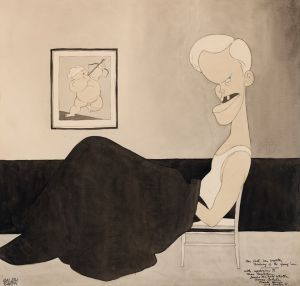
Charles Spurgeon Johnson
A hand-painted replica of Winold Reiss’s masterpiece Charles Spurgeon Johnson, meticulously crafted by professional artists to capture the true essence of the original. Each piece is created with museum-quality canvas and rare mineral pigments, carefully painted by experienced artists with delicate brushstrokes and rich, layered colors to perfectly recreate the texture of the original artwork. Unlike machine-printed reproductions, this hand-painted version brings the painting to life, infused with the artist’s emotions and skill in every stroke. Whether for personal collection or home decoration, it instantly elevates the artistic atmosphere of any space.
Winold Reiss was a German-American artist known for his portraits and illustrations, particularly those depicting African American and Native American subjects. One of his notable works is the portrait of Charles Spurgeon Johnson, an influential African American sociologist and a prominent figure during the Harlem Renaissance. This portrait is a significant piece of art as it captures the essence of a key intellectual and cultural movement in African American history.
Charles Spurgeon Johnson was born on July 24, 1893, in Bristol, Virginia. He became a pivotal figure in the Harlem Renaissance, a cultural, social, and artistic explosion that took place in Harlem, New York, during the 1920s. Johnson was a sociologist by training and played a crucial role in advocating for racial equality and documenting the African American experience. He was instrumental in organizing the first National Negro Congress in 1936 and served as the editor of the influential magazine "Opportunity: A Journal of Negro Life," which provided a platform for African American writers and artists.
Winold Reiss, born in 1886 in Karlsruhe, Germany, immigrated to the United States in 1913. He was deeply influenced by his father, who was also an artist, and developed a keen interest in portraying diverse cultures. Reiss's work is characterized by its vivid use of color and attention to detail, which is evident in his portrait of Charles S. Johnson. Reiss's portraits often went beyond mere representation, capturing the dignity and individuality of his subjects, which was particularly significant during a time when African Americans were fighting for recognition and equality.
The portrait of Charles S. Johnson by Winold Reiss is a testament to the collaboration and mutual respect between the artist and his subject. Reiss's ability to capture Johnson's intellectual presence and his contribution to African American culture is evident in the portrait's composition and execution. The artwork reflects Reiss's commitment to portraying African Americans with dignity and respect, challenging the prevailing stereotypes of the time.
Reiss's work, including the portrait of Charles S. Johnson, played a crucial role in the Harlem Renaissance by providing visual representation to the movement. His portraits were featured in various publications and exhibitions, helping to bring African American culture and achievements to a broader audience. Reiss's collaboration with African American intellectuals and artists was instrumental in promoting a more inclusive and diverse representation of American culture.
The portrait of Charles S. Johnson remains an important piece of art, not only for its artistic merit but also for its historical significance. It serves as a reminder of the contributions of African American intellectuals to American society and the role of artists like Winold Reiss in documenting and celebrating these achievements. Through his art, Reiss helped to foster a greater understanding and appreciation of African American culture, making his work an enduring legacy of the Harlem Renaissance.










![Graphic designs for Longchamps Restaurants.] [Cocktail card](/imgs/249257/s/winold-reiss-graphic-designs-for-longchamps-restaurants-cocktail-card-a188d857.jpg)
![[Design drawing for Manhattan House Longchamps Restaurant, corner of 3rd Avenue and 65th Street, New York, NY.] [Study for mosaic front](/imgs/249260/s/winold-reiss-design-drawing-for-manhattan-house-longchamps-restaurant-corner-of-3rd-avenue-and-65th-street-new-york-ny-study-for-mosaic-front-441f1ed6.jpg)
![Designs and photographs for alterations to St. James Bar Restaurant, W. 181st St. and Broadway, New York, NY.] [Incomplete study of exterior elevation](/imgs/249307/s/winold-reiss-designs-and-photographs-for-alterations-to-st-james-bar-restaurant-w-181st-st-and-broadway-new-york-ny-incomplete-study-of-exterior-elevation-15d88bd6.jpg)
![Drawings for proposed decorations of Mike Lyman’s Restaurant, 424 W. Sixth St., Los Angeles, CA.] [Color scheme for ceiling, playroom – bar – foyer](/imgs/249337/s/winold-reiss-drawings-for-proposed-decorations-of-mike-lymans-restaurant-424-w-sixth-st-los-angeles-ca-color-scheme-for-ceiling-playroom-bar-foyer-ba71c61c.jpg)
![Interior perspective drawings of Hotel Siwanoy, Mount Vernon, NY.] [Interior perspective study of Grill in red, yellow, and orange](/imgs/249369/s/winold-reiss-interior-perspective-drawings-of-hotel-siwanoy-mount-vernon-ny-interior-perspective-study-of-grill-in-red-yellow-and-orange-5860095.jpg)

![Design sketches for Hotel Alamac, 71st and Broadway, New York, NY.] [Sketch for Medieval Grill Murals](/imgs/249415/s/winold-reiss-design-sketches-for-hotel-alamac-71st-and-broadway-new-york-ny-sketch-for-medieval-grill-murals-6dec3039.jpg)

